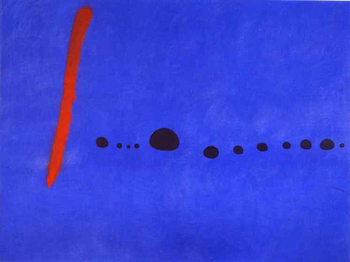| Search Art Prints | ||||||||||||||||||||
| Search Artists | ||||||||||||||||||||

|
||||||||||||||||||||
|
|
|||||||||||||||||||

Blue II

|
Blue II
Blue II, along with the appropriately titled Blue I and Blue III, is part of a triptych. The paintings can be viewed separately, but they are all based around the same theme, and similarly executed. All are plays on Miró's earlier horizon-line paintings like Landscape and Painting (with their use of simple lines as their central elements) and together anticipate his 1962 work, Mural Painting for a Temple III. Blue II's closest links, however, are the similar paintings Miró executed many years before, in the mid-1920s, when open blue fields had particular associations for the artist. Quite unlike that period though, which was marked by timid brushwork, and a lack of clear direction, Miró's draftsmanship and punctuating black splotches have a subtle authority and confidence here. The piece has an unmistakable air of mastery about it notably absent from its earlier counterparts.
Although it would appear that Miró does everything here overly simply, he is in fact accomplishing everything merely with extreme economy. The entirety of the huge monochromatic surface is enlivened by the inventive, sparse brushwork. The vibrations of the austere line animate an enormous amount of space. The black dots serve to break up and extend the strength that the line radiates outward, throughout the blue space. What would be a monotonous field of a single color is instead charged, even electrified. From this, the piece derives a monumental quality. In other canvases, Miró achieved this same monumental aspect with strong outlines and contrasted areas of pure color blending together. Here, he is able to reach the same ends with much simpler means.











